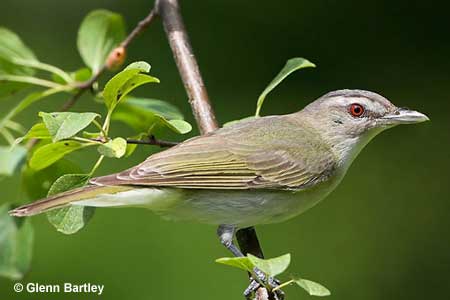The Red-eyed Vireo is a small, plain, sparrow-sized bird.
One of the more common migratory birds in Canada and the United States, The Red-eyed Vireo breeds in forests and even big city parks and cemeteries.
It lives in many places but is often overlooked. This small bird has a natural ability to hide in leafy vegetation, especially in the canopy of tall trees.
On this page
Breeding Male
The male Red-eyed Vireo is a small bird that is olive above, white below, and with a pale eyebrow, and gray cap with narrow black border. It also has a dark line through a reddish eye. Males look like females but are slightly larger, weighing one gram more on average.
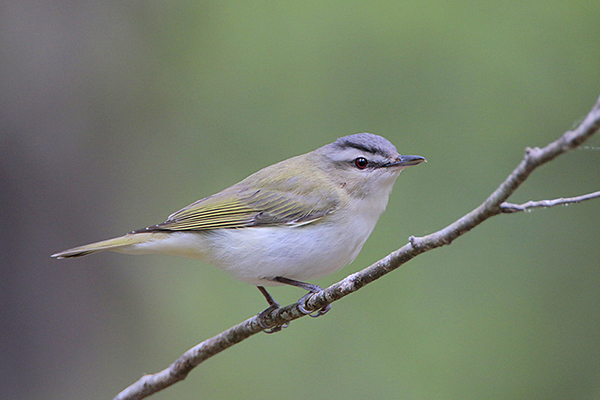
Photograph © Greg Lavaty.
Female
Female Red-eyed Vireos look exactly like males but are slightly smaller, weighing around 19 grams compared to 20 grams of the male.
Juvenile
The juvenile Red-eyed Vireo looks like the adult but is a bit paler. It is also less marked on the head and has brownish eyes. They hatch after two weeks and depend on their mother for 30 days more.
Habitat
The Red-eyed Vireo lives in deciduous and mixed deciduous and coniferous forest. They build their nests in the fork of a branch of a leafy tree three to 60 feet above the ground.
Diet
The Red-eyed Vireo feeds on various insects, including flies, beetles, cicadas, insect larvae, and small fruits. This small bird forages for insects by slowly moving along branches in leafy vegetation.
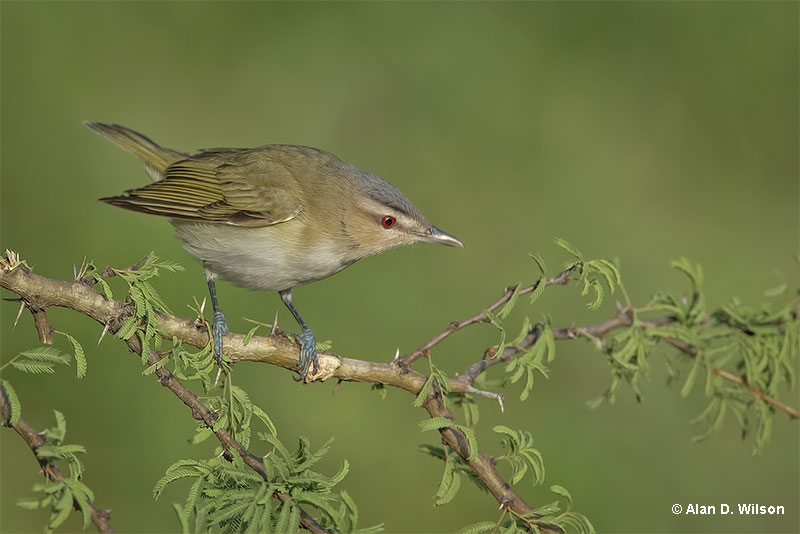
© Alan D. Wilson
It carefully inspects the foliage and twigs to find hidden prey. After checking one tree, they fly a short distance to the next tree and continue their methodical foraging.
Caterpillars make up a big part of their diet. Depending on the size of the larvae, they can be swallowed whole, beaten against a branch, or held down with one of their feet while they eat the caterpillar bit by bit.
This species usually forages high above the ground but can also forage in small trees and shrubs, usually in deciduous vegetation. During late summer, migration, and on its wintering grounds in the Amazon, the Red-eyed Vireo also feeds on small fruits.
They take berries and fruits from Elderberry, Virginia Creeper, Dogwood, Spice Bush, and various tropical plant species.
Behavior
On their breeding grounds, the Red-eyed Vireo forages alone. However, during migration and on its wintering grounds, this species often forms flocks with other vireos and warblers.
It also gives a raspy alarm call when a hawk, owl, snake, or other predator is spotted but doesn’t seem to fear people.
Range (and seasonal changes)
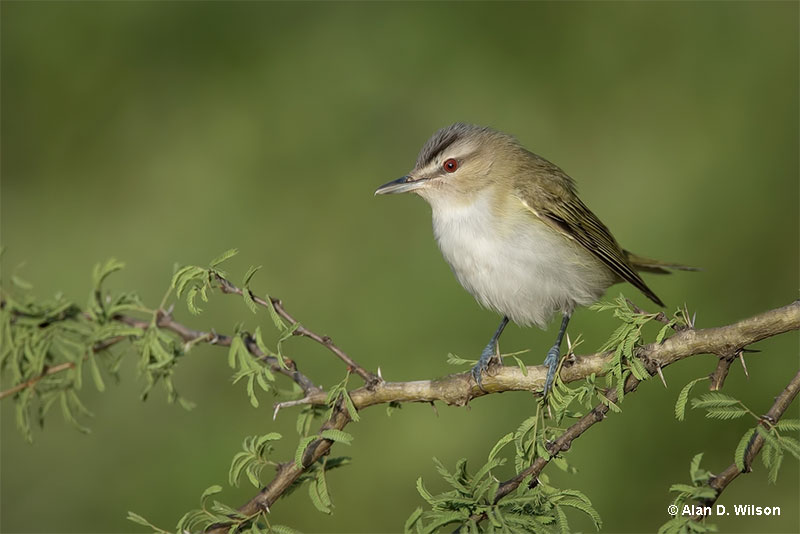
© Alan D. Wilson
Red-eyed Vireos breed in deciduous and mixed deciduous/coniferous forests and woodlands from the Northwest Territories south through central and southern Canada east to Nova Scotia.
They also occur in much of the northern, central, and eastern USA. In September, they migrate to the Amazon and return to breeding grounds in May.
Wing shape
The wings of the Red-eyed Vireo are fairly long, with primaries that extend well beyond the rest of the wing. This helps them migrate long distances to and from breeding grounds in Canada and the USA all the way to the Amazon basin. The wingspan of this bird is 9.1 to 9.8 inches.
Fun Facts
- The spiritual meaning of the Red-eyed Vireo is that of hope, faith, and good fortune. The constant cheery song of this small bird reminds us to stay positive, have faith in our beliefs, and have the strength to meet our goals.
- Like many other migrant bird species, the Red-eyed Vireo migrates at night and is partially guided by an internal magnetic “compass” that helps it stay on course during its long journey to and from North and South America.
- The Red-eyed Vireo has a slightly hooked bill that may help it catch and kill large caterpillars.
- The Red-eyed Vireo sings so often, it has often been referred to as “The Preacher.” One individual was documented singing more than 22,0000 times in one day!
Call
The male Red-eyed Vireo constantly sings a cheery song of brief phrases, “Here I am..where am I? Up here! Here I am..“. Males and females also give a raspy, mewing call.
Similar Species
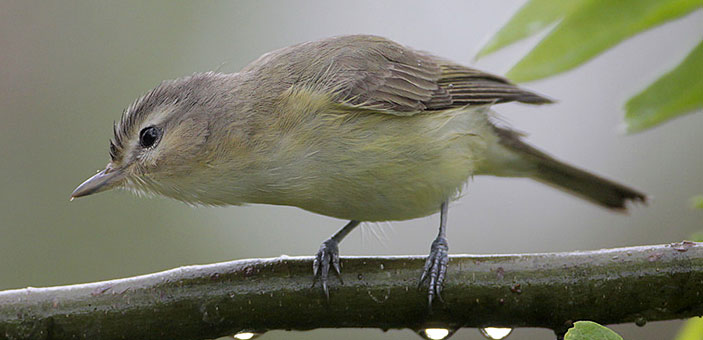
Warbling Vireo
Although the two look similar, Warbling Vireos have more brown on their plumages and are a bit smaller.
They also lack the red eyes that the Red-eyed Vireos have been named after.
Red-eyed Vireos have a bit more white on their bellies than Warbling Vireos.
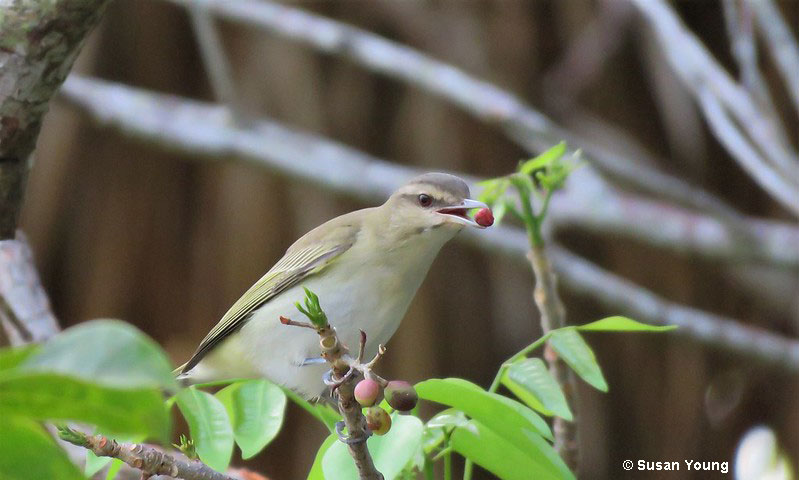
Black-whiskered Vireo. Photograph © Susan Young
Black-whiskered Vireo
Plumage-wise, Black-whiskered Vireos look similar to Red-eyed Vireos.
They have a similar bill and build, and the only difference is the “black whiskers” that start near their bill.
Black-whiskered Vireos are not too common in the U.S. They can be spotted in some southeastern parts, like Florida.
Frequently Asked Questions
Are Red-eyed Vireos common?
Red-eyed Vireos are one of the most common birds in North America. The species has an estimated population of 130,000,000.
Where are Red-eyed Vireos found?
Red-eyed Vireos live in leafy woodlands in many parts of Canada and the northern, central, and eastern United States of America.
Is the Red-eyed Vireo a carnivore?
The Red-eyed Vireo feeds on caterpillars, insects, and fruit.
What is the song of the Red-Eyed Vireo?
The song of the Red-eyed Vireo consists of brief phrases given over and over and sounds something like “Here I am..where am I? Up here! Here I am..“.

